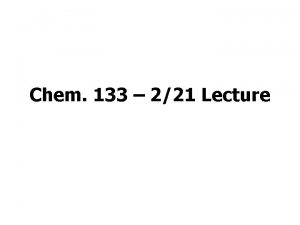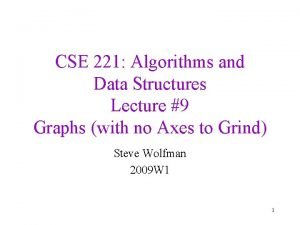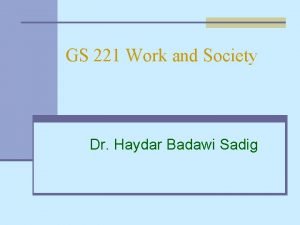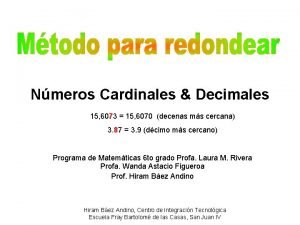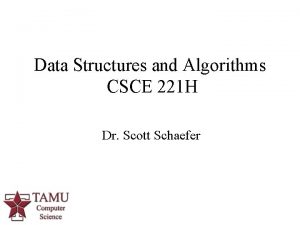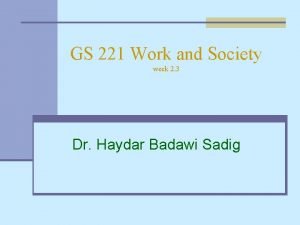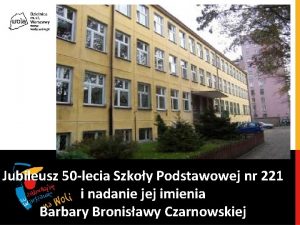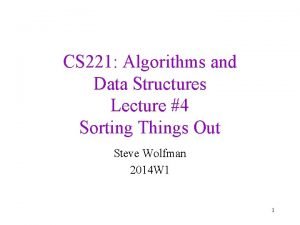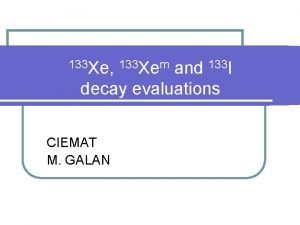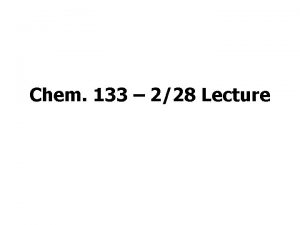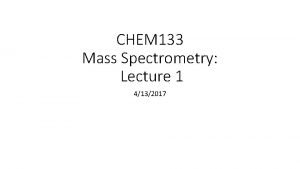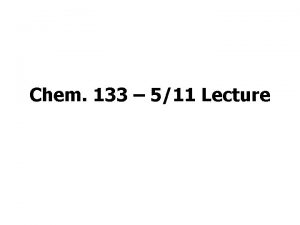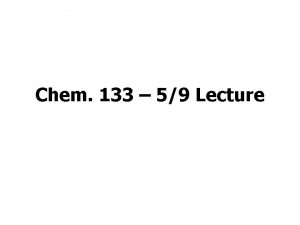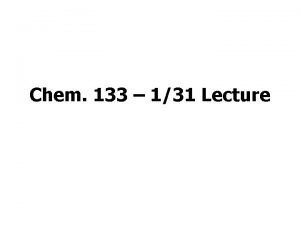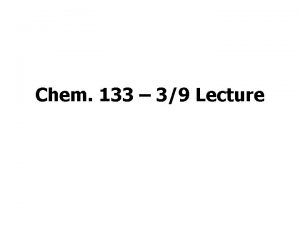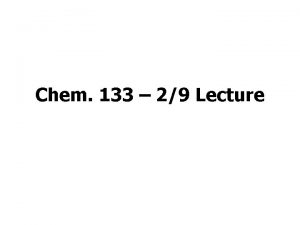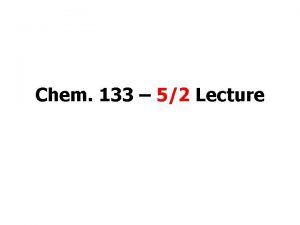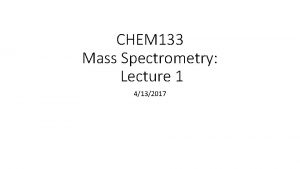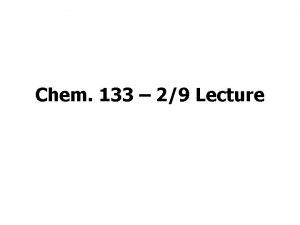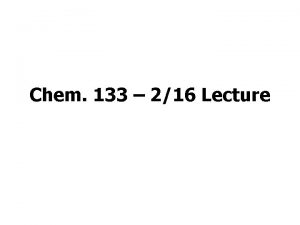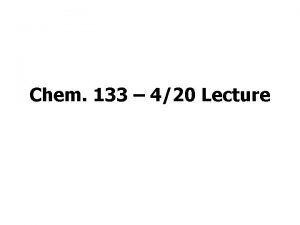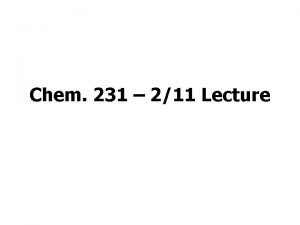Chem 133 221 Lecture Announcements Return Q 2



















- Slides: 19

Chem. 133 – 2/21 Lecture

Announcements • Return Q 2 and HW 1. 2 – I thought Q 2 was reasonable – scores were o. k. , but not great – Some parts of homework (e. g. I wanted you to use Excel to solve 1. 2. 3 and to calculate Sx – the standard uncertainty in the conc. – for each sample) were not clear so will make 2 points bonus (out of 6 points) • Missing Office Hours on Friday • Today’s Lecture – Noise – Electrochemistry

Noise Sources – Other Types A. Flicker Noise (or 1/f noise or pink noise) - Occurs at low frequencies - Can result from environmental changes (e. g. change in light intensity over time, change in temperature) - Can be reduced through “modulation” – see next slide

Noise Flicker Noise Example of equipment (including modulation) for noise reduction chopper (alternatively reflects light or lets light through) sample cell light detector high pass filter lamp blank cell rectifier To Digitizer mirrors

Noise Flicker Noise Example: Signals detector signal Signal following digital filtration RClight Filter only + diode low f noise removed slow increase in noise over 1 st ~100 s

Noise Sources – Other Types B. Interference – Noise originating from other electrical signals (especially ones that use more power) – Examples: 60 Hz from power lines, spikes from solenoids, turning heaters on/off – Solution to problems: 1) use shielded cables, 2) shield major power sources, 3) use differential amplifiers

Noise Processing to Reduce • Both analog and digital means can be used to reduce noise • Band width reduction can reduce noise • Low pass filters (e. g. RC filters) reduce high frequency noise but lose high frequency signals • Similar methods (e. g. moving averages) for removing high frequency noise can easily be done on digital data • A separate way to reduce noise is to signal average (e. g. collection and averaging spectra), provided experiment can be replicated closely

Noise Processing to Reduce • Example of moving average (0. 5, 2, 10, and 30 s) to remove high frequency noise Raw + 2 s data Raw + 30 Data s data Definite reduction of Hz) Raw + 0. 5 s data (collected at 10 Clearly over filtered noise observed (resolution lost by 5 0. 1 s points averaged to broadening) make 0. 5 s point Only slight reduction of noise observed Raw + 10 s data Even more noise reduction observed, but peak starting to broaden and flatten

Noise HPLC Example S/N Peak Width at half height Type Noise Baseline Signal Baseline corrected signal Unfiltered 0. 002891 0. 999447 1. 0519 0. 052470125 18 0. 202 0. 5 s MA 0. 002166 0. 999461 1. 0489 0. 049437891 23 0. 202 2 s MA 0. 001232 0. 99946 1. 0458 0. 046335795 38 0. 2282 10 s MA 0. 000535 0. 999457 1. 0414 0. 041971743 79 0. 255 30 s MA 0. 00047 0. 999512 1. 0221 0. 022616734 48 0. 507 Best S/N with 10 s filter Minimal increase in peak width until 2 s

Noise Questions 1. 2. 3. 4. 5. 6. 7. What type of noise is likely to be present when using thermocouples to measure temperature? Why is modulation normally required to reduce 1/f noise? What is the percent noise on a current producing transducer which generates signal over a 1000 Hz band if the signal is 10 n. A? if the signal is 2. 0 p. A? What specific type of noise is reduced best by shielding electronics? How would use of a low pass filter reduce shot noise? Suggest one method for reducing thermal noise. What type of noise is not effectively reduced by using a low pass filter?

Electronics Additional Questions • Answer the questions 1 -3 from the following plots which were obtained from background measurements (instrument noise): a) 1. Which plot is most likely shows 1/f noise: ___________ 2. Which plot when Fourier transformed b) will produce a plot with a peak at 55 Hz: _______ 3. If plot c) shows noise from a GC signal in which peaks typically are on the c) order of 2 s (2000 ms) wide, what can be done to reduce the noise?

Electrochemistry Overview • Applications – quantitative analysis • potential measurement methods (e. g. p. H electrode) • current based measurements (amperometry) – qualitative analysis (voltammetry) – note: potential normally gives qualitative information and current quantitative measurements (except with ion selective electrodes/p. H meters) – HPLC/IC detectors • Why Use? – lower cost (both for instruments and supplies) – high sensitivity possible (particularly mass sensitivity) – simpler equipment, more useful for field, in-situ type measurements

Electrochemistry Redox Reactions • Reduction = loss of charge – e. g. Fe 3+ + e- → Fe 2+ • Oxidation = gain in charge – e. g. Pb 2+ + 2 H 2 O → Pb. O 2(s) + 4 H+ + 2 e- (Pb goes from +2 to +4) • Balancing reactions – review steps in general chemistry book – example: Zn(s) + Cr 2 O 72 - → Zn 2+ + Cr 3+ – note: based on methods used for problems in this book, full cell balancing may not be needed

Electrochemistry Fundamental Equations • Relationship between charge, energy and current – redox reactions involve the exchange of electrons – when the exchange occurs on an electrode surface, current can be measured – Total charge transfer = q = n. F, where • n = moles of electrons in reaction and • F = Faraday’s constant = 96500 C/moles e • F = NAvogadro·e (e = elementary charge = 1. 6 x 10 -19 C) – Current Produced = I = dq/dt • or q = ∫I·dt (or = I·t under constant current conditions) • can be used to determine battery lifetime

Electrochemistry Fundamental Equations • Relationship between charge, energy and current (continued) – Electrical work (units = J) = E·q (E = potential in volts and q in C) – and ΔG = -E·q = -n. FE – under standard conditions (1 M reactant/product conc. , 298 K, etc. ), ΔGº = -n. FEº – ΔGº are given in Tables and allows calculation of K values – Eº, standard reduction potential, also given in Tables (see Appendix H), but for “half-reactions”

Electrochemistry Fundamental Equations • Example problem: A Ni. Cad battery contains 12. 0 g of Cd that is oxidized to Cd(OH)2. How long should the battery last if a motor is drawing 421 m. A? Assume 100% efficiency.

Electrochemistry Galvanic Cells • What are galvanic cells? GALVANIC CELL – Cells that use chemical reactions to generate electrical energy – Batteries are examples of Zn(s) useful galvanic cells – Example reaction voltmeter Ag(s) Zn(s) + 2 Ag+ → Zn 2+ + 2 Ag(s) – If reactants are placed in a beaker, only products + heat are produced – When half reactions are isolated on electrodes, Zn. SO 4(aq) electrical work can be produced Ag. NO 3(aq) Salt Bridge

Electrochemistry Galvanic Cells • Description of how example cell works GALVANIC CELL – Reaction on anode = oxidation voltmeter – Anode = Zn electrode (as the Eº for Zn 2+ is less than for that for Ag+) Zn(s) – So, reaction on cathode must be reduction and involve Ag – – Oxidation produces e , so anode has (–) charge (galvanic cells only); current runs from cathode to anode – Salt bridge allows replenishment of ions as cations migrate to cathode and anions toward anodes Zn. SO 4(aq) Zn(s) → Zn 2+ + 2 e- Ag+ + e- → Ag(s) + Salt Bridge Ag(s) Ag. NO 3(aq)

Electrochemistry Galvanic Cells • Cell notation GALVANIC CELL – Example Cell: voltmeter Zn(s)|Zn. SO 4(aq)||Ag. NO 3(aq)|Ag(s) Zn(s) Ag(s) “|” means phase boundary left side for anode (right side for “||” means salt bridge cathode) Ag. NO 3(aq) Zn. SO 4(aq) Salt Bridge
 133 221
133 221 What two announcements did montag hear
What two announcements did montag hear Pvu market cap
Pvu market cap Kluver bucy syndrome
Kluver bucy syndrome R/announcements!
R/announcements! General announcements
General announcements David ritthaler
David ritthaler 01:640:244 lecture notes - lecture 15: plat, idah, farad
01:640:244 lecture notes - lecture 15: plat, idah, farad Cse 221
Cse 221 Tamu csce 221
Tamu csce 221 221 bc
221 bc Sebuah kapasitor
Sebuah kapasitor Csce 221 tamu syllabus
Csce 221 tamu syllabus Gs-221
Gs-221 Una decena de millar mas tres centesimos
Una decena de millar mas tres centesimos Csce 222
Csce 222 Gs-221
Gs-221 Sp 221
Sp 221 Cs 221
Cs 221 Cpit 221
Cpit 221
